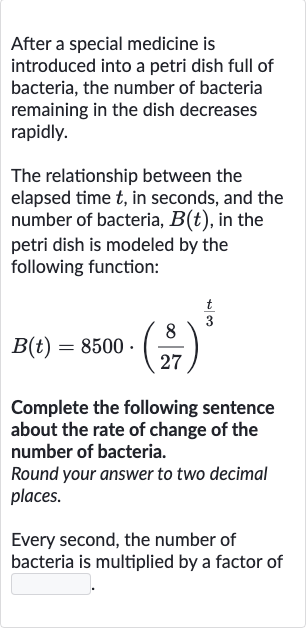AI tutor
Welcome to Bytelearn!
Let’s check out your problem:

After a special medicine is introduced into a petri dish full of bacteria, the number of bacteria remaining in the dish decreases rapidly.The relationship between the elapsed time , in seconds, and the number of bacteria, , in the petri dish is modeled by the following function:Complete the following sentence about the rate of change of the number of bacteria.Round your answer to two decimal places.Every second, the number of bacteria is multiplied by a factor of
Full solution
Q. After a special medicine is introduced into a petri dish full of bacteria, the number of bacteria remaining in the dish decreases rapidly.The relationship between the elapsed time , in seconds, and the number of bacteria, , in the petri dish is modeled by the following function:Complete the following sentence about the rate of change of the number of bacteria.Round your answer to two decimal places.Every second, the number of bacteria is multiplied by a factor of
- Identify Function and Variable: Identify the given function and the variable of interest.The function models the number of bacteria over time.
- Determine Exponential Function Base: Determine the base of the exponential function that represents the rate of change per second.The base is , which is raised to the power of . To find the rate of change per second, we need to evaluate the base raised to the power of , since is measured in seconds.
- Calculate Multiplication Factor: Calculate the factor by which the number of bacteria is multiplied every second. The factor is , because every second increases by , and we are interested in the change from to .
- Simplify Expression for Factor: Simplify the expression to find the factor.Factor = Use a calculator to find the cube root of .Factor Factor (rounded to four decimal places)
- Round Factor to Two Decimal Places: Round the factor to two decimal places as instructed.Factor (rounded to two decimal places)
